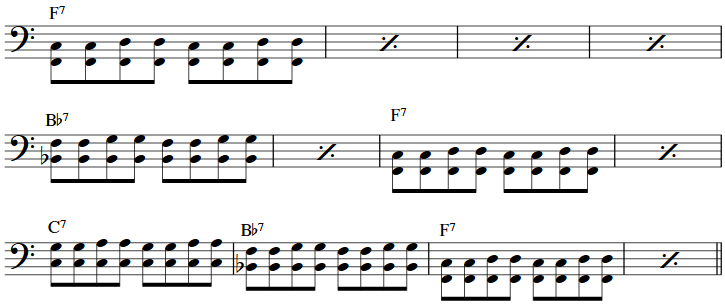How to Play a Blues Shuffle

Learning how to play a blues shuffle is a critical and immediately useful skill for all blues and jazz players, and it's a particularly fun skill to acquire for pianists. In this article, I'm going to show you a few steps that you can use in your practice sessions to learn how to play a blues shuffle. We'll approach this by looking first at the left hand and then adding a right hand comping groove and using the 12-bar blues form as our template. Let's get started!
The Left-Hand Bass Line Shuffle
We're going to start by learning a very common and frequently played left hand shuffle groove. This groove focuses on outlining the chord changes of the 12-bar blues form but the primary focus is going to be getting the left hand to play with a triplet-based shuffle feel.
The notes of the left hand bass line consists of two chord shell shapes - the root and 5th, and the root and 6th. Below is a 12-bar blues form in the key of 'F' that shows the notes used for each chord as we move this bass line through the I, IV, and V chords.
Although written as 8th notes, we are going to feel (and therefore play) the bass line as though it is written as follows:
In order to play the blues shuffle groove, we really need to play the 8th notes with a triplet feel as written above.
Listen to the difference in the two grooves - the first four bars are a shuffle/triplet feel, and the next 4 bars are a straight-8th note feel.
Practice playing through the left hand bass line in various keys, focusing on mastering the triplet-shuffle feel and gradually increasing your tempo.
The Right Hand Comping Groove
Next, we're going to learn a 2-bar right hand groove that we will transpose through the three chords of the blues form (the I, IV, and V chords). We'll then lay that groove over the bass line. Again, this right hand groove is going to have a shuffle-triplet feel in the 8th notes.
The groove uses notes from the mixolydian scale of each chord change. Let's look at the groove over the F7 chord, remembering that although we're going to write the groove like this...
We're going to play it as though it were written like this:
Be sure to practice the right hand part separately before trying to play hands together.
Next, let's transpose this right hand groove so that we can play it over the Bb7 chord.
Be sure to transpose the right hand groove to C7 so that you will be able to play the groove through the entire form.
When putting hands together, remember to start slowly and loop particular sections to maximize your efficiency. For example, practice playing through the 2-bar F7 groove repeatedly, then Bb7, then C7, before trying to play through the entire 12-bar form.




